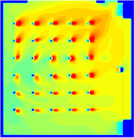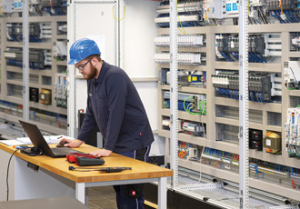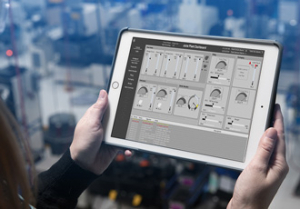Airflow Simulation Helps Retrofit Schools for Air Conditioning with Minimum Energy Usage
11th November 2008
Source:
Flomerics

AECOM consultants used FloVENT computational fluid dynamics (CFD) software from the Mentor Graphics Mechanical Analysis Division (formerly Flomerics) to determine the viability of and guidelines for the use of thermal displacement ventilation (TDV) for schools in Southern California. AECOM used FloVENT CFD software, which is designed specially for building interior spaces, to simulate the use of TDV in various classroom configurations. TDV demonstrated the ability to provide comfortable classrooms at energy consumption levels considerably lower than conventional air conditioning systems.
TDV works by introducing cool air at around 65oF, compared to 55oF for a standard mixed system, at low velocity at a low level by using either a raised floor or terminals around the perimeter of the space. Sources of heat such as people and equipment warm the air, causing it to rise and take with it moisture and contaminants such as carbon dioxide from people. Compared to a standard mixing system, TDV reduces energy consumption because it is only necessary to cool the occupied zone. The hours in the year when free cooling is available are also far greater for a TDV system than for a mixed system with economizer. The reason is that the supply air temperature is considerably higher than in a mixed system.
“We have a number of different CFD codes in our company,” said Jim Saywell, an engineer for AECOM. “But I use FloVENT whenever a project involves building interiors because it is designed specifically for modeling heating, ventilation and air-conditioning (HVAC) applications so it is both easier and quicker to use than general purpose CFD codes. FloVENT also offers a team of support engineers that have a very good understanding of building cooling issues.”
FloVENT was used to analyze otherwise identical classrooms with different ceiling heights to establish a minimum that could be used as a filtering process for which schools, or classrooms within schools could use this technology. “It was decided that the best guidance we could give was never to implement TDV on a classroom with a ceiling lower than 8 ½ feet and it was recommended that the ceiling height should be at least 9 feet,” Saywell said. “Some classrooms have sloped ceilings. In these cases if the average height of the ceiling is above 9 feet then this will usually be sufficient height for a TDV strategy to function properly.
The next step was finding the most effective layout of terminals that would have a minimal impact on the way teachers could make use of the space. The goal was to take as little perimeter space away from the classroom as possible, while still providing enough cooling and fresh air to the whole room. “The simulation results showed that providing two terminals with as narrow a width as possible, capable of supplying 600 cfm each was sufficient to provide acceptable air distribution,” Saywell said.
After developing guidelines for the use of TDV, AECOM installed TDV in a few pilot schools. TDV demonstrated the ability to provide comfortable classrooms at energy consumption levels considerably lower than conventional air conditioning systems. With the guidelines in place, competitive bidding will be used to select contractors to install TDV in the remaining schools based on the guidelines.
“We have a number of different CFD codes in our company,” said Jim Saywell, an engineer for AECOM. “But I use FloVENT whenever a project involves building interiors because it is designed specifically for modeling heating, ventilation and air-conditioning (HVAC) applications so it is both easier and quicker to use than general purpose CFD codes. FloVENT also offers a team of support engineers that have a very good understanding of building cooling issues.”
FloVENT was used to analyze otherwise identical classrooms with different ceiling heights to establish a minimum that could be used as a filtering process for which schools, or classrooms within schools could use this technology. “It was decided that the best guidance we could give was never to implement TDV on a classroom with a ceiling lower than 8 ½ feet and it was recommended that the ceiling height should be at least 9 feet,” Saywell said. “Some classrooms have sloped ceilings. In these cases if the average height of the ceiling is above 9 feet then this will usually be sufficient height for a TDV strategy to function properly.
The next step was finding the most effective layout of terminals that would have a minimal impact on the way teachers could make use of the space. The goal was to take as little perimeter space away from the classroom as possible, while still providing enough cooling and fresh air to the whole room. “The simulation results showed that providing two terminals with as narrow a width as possible, capable of supplying 600 cfm each was sufficient to provide acceptable air distribution,” Saywell said.
After developing guidelines for the use of TDV, AECOM installed TDV in a few pilot schools. TDV demonstrated the ability to provide comfortable classrooms at energy consumption levels considerably lower than conventional air conditioning systems. With the guidelines in place, competitive bidding will be used to select contractors to install TDV in the remaining schools based on the guidelines.
Similar articles
More from Flomerics
- Laser Design Offers SLP-500 High-Speed Laser Probe 14th May 2009
- Simulation Helps Develop Spray Gun with 50% Larger Pattern in Significantly Less Time 30th April 2009
- Giles Gaskell Joins Laser Design & GKS Inspection Services Team 17th March 2009
- Embedded CFD Helps Reduce Number of Thermal Prototypes from Up to 12 to 1 4th March 2009




 technology at Jacobs Vehicle Systems.JPG)







Write a comment
No comments